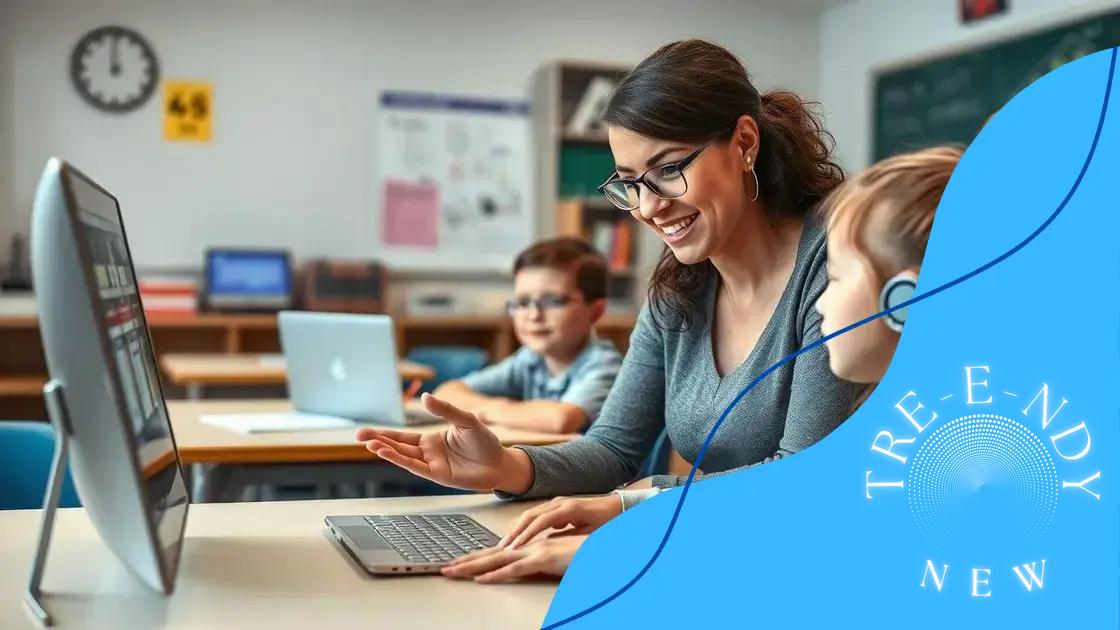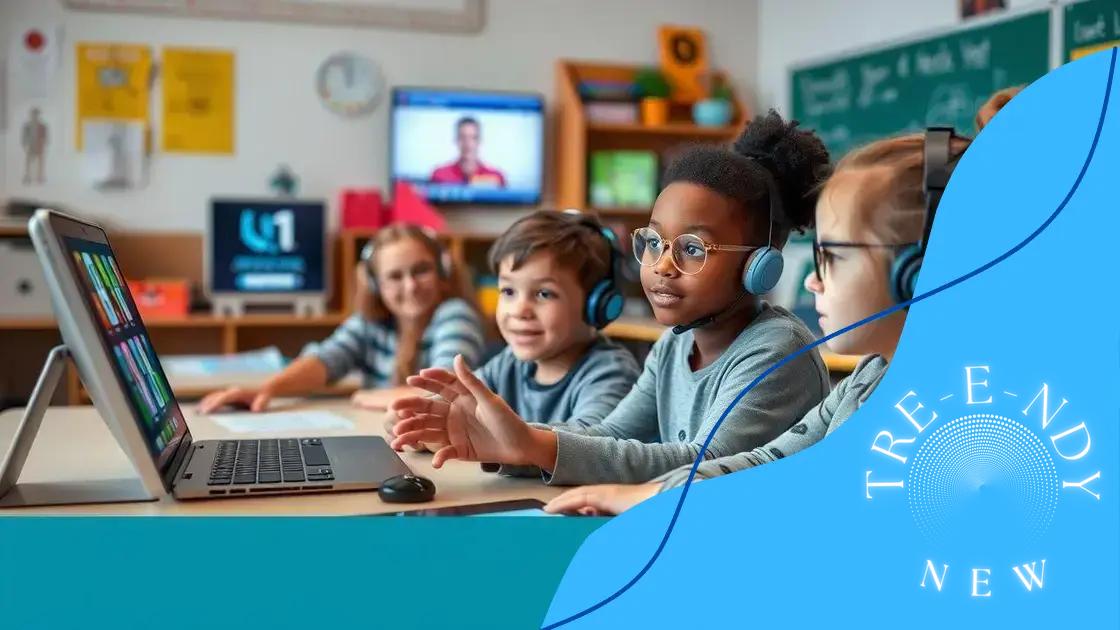AI support for special needs education is transforming lives

AI support for special needs education enhances personalized learning, facilitates communication, and improves accessibility, addressing the unique challenges faced by students and educators in inclusive classrooms.
AI support for special needs education is reshaping how educators approach learning for students with diverse requirements. Imagine a classroom where every child receives personalized assistance. In this article, we’ll explore the tools and strategies that make this possible.
Understanding AI in special needs education
Understanding AI in special needs education is essential for educators and parents alike. With the rapid advancement of technology, AI offers unique solutions to support students with diverse needs.
AI can analyze patterns in data to tailor learning experiences for each child. Schools are increasingly using these tools to create customized educational programs. For example, AI can help identify the strengths and weaknesses of students, enabling teachers to provide targeted assistance.
Key Applications of AI
Some significant applications of AI in special needs education include:
- Personalized Learning: AI systems adapt content to fit the learning pace and style of each student.
- Language Assistance: AI tools can help students with communication challenges enhance their language skills.
- Behavior Monitoring: AI can track students’ progress and behavior, allowing for timely interventions.
These innovations create more inclusive environments by promoting equity in learning opportunities. Another vital aspect is the way AI facilitates communication. Students with speech and language difficulties benefit greatly from AI-based tools designed to aid their expression.
The Role of Educators
While AI can significantly enhance learning, its success relies on educators’ ability to integrate it into the classroom effectively. Teachers need training to understand how to use these tools efficiently. Additionally, collaboration between parents and educators is crucial in leveraging AI’s benefits to support students with special needs.
This collaboration can lead to better strategies that take into account individual circumstances. Schools must ensure that every voice is heard and that each child’s needs are met.
Benefits of AI for students with special needs
Benefits of AI for students with special needs are vast and transformative. As schools integrate AI technologies, the support for these students improves significantly. Educational tools powered by AI can address individual strengths and weaknesses effectively, creating a more inclusive learning environment.
AI-driven platforms offer personalized learning experiences that allow students to progress at their own pace. For example, an AI system can track a student’s performance and adjust the difficulty of tasks accordingly. This helps keep students engaged and motivated.
Key Advantages of AI
Some key advantages of AI in education for students with special needs include:
- Enhanced Accessibility: AI tools can help break down barriers, making learning materials available in various formats.
- Personalized Attention: AI provides tailored feedback and support, catering to each student’s unique needs.
- Improved Communication: Tools like speech recognition enable students with communication challenges to express themselves better.
By utilizing AI, educators can implement strategies that better accommodate different learning styles. This personalization not only benefits the students but also enriches the classroom experience for everyone.
Moreover, AI systems can assist in behavior tracking. These tools allow teachers to monitor student interactions and engagement, enabling early identification of any issues that may arise. This proactive approach creates a supportive atmosphere where students feel understood and valued.
Successful AI tools for special needs support

Successful AI tools for special needs support are changing the educational landscape. Various technologies can assist students with unique challenges, offering tailored solutions that cater to individual needs.
One significant tool is speech recognition software, which allows students with speech difficulties to communicate more effectively. This technology can convert spoken words into text, enabling students to express themselves with greater ease.
Popular AI Tools
Several AI tools are gaining popularity for their effectiveness in supporting special needs education. Some of these tools include:
- Learning Ally: This app provides audio support for textbooks, making it easier for students with reading difficulties to access learning material.
- BrainPOP: An engaging educational platform that uses animated videos and quizzes to cater to different learning styles.
- ModMath: An application designed specifically for students with dyscalculia, helping them solve math problems digitally.
These tools are not only innovative but also foster independence in students. By using AI technology, educators and parents can empower students to take an active role in their learning journey.
Moreover, many AI tools constantly learn and adapt, ensuring that the support they provide evolves with the students’ needs. This adaptability is crucial, as it allows for ongoing growth and development in academic performance. With the integration of these technologies, classrooms become more inclusive and diverse, providing all students with the opportunities they deserve.
Challenges in implementing AI in education
Challenges in implementing AI in education can significantly affect the effectiveness of these advanced technologies. Despite the numerous benefits AI offers, there are hurdles that must be addressed to ensure successful integration into classrooms.
One major challenge is the cost of technology. Schools often struggle with tight budgets, making it difficult to invest in AI tools. Additionally, the ongoing maintenance and updates require further financial resources that may not be available.
Additional Barriers
Other challenges include:
- Lack of Training: Teachers and staff may not receive adequate training to utilize AI tools effectively, which can hinder their ability to implement these technologies.
- Data Privacy Concerns: Implementing AI involves collecting student data, raising issues regarding privacy and security.
- Resistance to Change: Some educators may resist integrating AI due to fear of change or unfamiliarity with new technologies.
Moreover, technology can sometimes face reliability issues. AI systems may not work as intended, leading to frustration among educators and students alike. These problems can cast doubt on the overall effectiveness of AI in improving educational outcomes.
Besides these operational challenges, ensuring that AI tools are developed with every student’s needs in mind remains crucial. By focusing on the unique requirements of special needs education, developers can create more effective solutions. Addressing these challenges will require collaboration among educators, technology providers, and policymakers.
Future trends in AI and special education
Future trends in AI and special education promise exciting advancements that can greatly enhance learning experiences for students with special needs. As AI technology continues to evolve, it is shaping the way educators approach personalized learning and student support.
One significant trend is the development of adaptive learning platforms. These platforms use AI to assess a student’s learning style and adjust content accordingly. This means that lessons can become more engaging and suited to individual needs, allowing students to thrive.
Emerging Technologies
Several emerging technologies are poised to impact special education, including:
- Virtual Reality (VR): VR can create immersive learning experiences, helping students with specific challenges engage in ways that traditional methods may not achieve.
- Machine Learning: This technology enables systems to learn from student interactions, providing increasingly accurate support and adjustments over time.
- Natural Language Processing: AI that understands and processes human language can enhance communication tools for students with speech or language impairments.
By integrating these technologies, classrooms can become more inclusive and supportive environments. Importantly, collaboration between educators, developers, and families will be essential to ensure that technologies meet the diverse needs of all students.
As we look to the future, the emphasis will be on creating a seamless blend of technology and teaching practices that focus on student empowerment. With ongoing advancements in AI, the potential for tailored educational experiences grows, benefiting learners in unprecedented ways.
FAQ – Frequently Asked Questions about AI in Special Needs Education
What are the main benefits of using AI in special needs education?
AI provides personalized learning experiences, enhances accessibility, and fosters effective communication for students with special needs.
How can AI tools help teachers in the classroom?
AI tools can assist teachers by tracking student progress, providing tailored resources, and identifying learning gaps for timely interventions.
What challenges do schools face when implementing AI?
Schools often encounter challenges such as budget constraints, lack of training for staff, and concerns about data privacy.
What future trends can we expect in AI and special education?
Future trends include the use of adaptive learning platforms, virtual reality experiences, and more advanced communication tools to support diverse learners.





